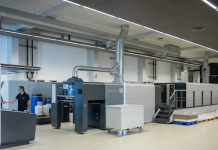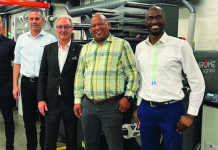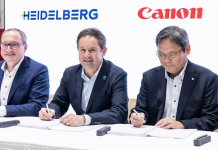Heidelbergs Print Media Centre in Wiesloch-Walldorf housed 80 representatives from label producers around the world in September. In the demonstration centre, Heidelberg showed how its packaging solutions could be used flexibly and highly productively for industrial label production.
Labels make up around 20 percent of the packaging printing segment worldwide. Global demand is currently growing at around 4.5 percent a year and production was approximately 49.2 billion square metres in 2012. The share of labels printed on sheetfed offset presses is growing strongly at present. With the growth rate at just 12 percent from 2006 to 2010, the print volume for this technology is expected to increase by 65 percent 4between 2010 and 2016.
Marcel Kiessling, Heidelberg Management Board member said, This market segment still offers a great deal of potential for many print shops. The shift from flexographic to sheetfed offset printing shows that this technology meets the manufacturers requirements for quality, productivity, flexibility, and sustainability in every respect. Our packaging printing solutions are ideal for label production. Label Days focused on the production of inmold labels made of polypropylene (PP) in sheetfed offset, complete with workflow and postpress. This market segment offers interesting growth potential, with average growth rates of 5.6 percent forecast through to 2020.
Heidelberg demonstrated the highly productive manufacture of inmold labels in sheetfed offset on a Speedmaster XL 106-6-P+L with a CutStar sheeter. The machine processed a print job using a 60 µm EUP film from manufacturer Treofan in perfecting mode at a speed of 10,000 sheets per hour. In straight mode, a transparent 57 µm ETH film was printed at a speed of 12,000 sheets per hour. The jobs were printed using UV inks and a water-based coating.
The sheets were dried using UV interdeck dryers and a DryStar UV Combination dryer in the quadruple-length delivery. Heidelberg offers its customers full flexibility in this area, with drying solutions developed specifically for this segment involving additional drying units located after the coating unit.
This perfecting press is an absolute first for the production of inmold labels printed on both sides, says Felix Müller, Head of Product Management Sheetfed at Heidelberg. Given the growing demand for more information on packaging, this solution gives manufacturers the opportunity to print promotions or consumer protection information on the back of an inmold label, for example.
Heidelberg a printing press manufacturer that offers the Speedmaster XL 106-D rotary die cutting press for finishing film sheets. Customer demands for a more cost-effective alternative to flatbed die cutters prompted Heidelberg to develop a new solution back in 2008. Eleven rotary die cutting presses have been installed worldwide, as their makeready times is approximately 15 minutes at production speeds of between 6,000 and 10,000 sheets per hour, the Speedmaster XL 106-D handles far more jobs each day than a flatbed die cutter, while the die cutting costs are around a third lower.
A demonstration on a Speedmaster XL 106-LYY-8-LYYL with the FoilStar cold foil module (L stands for coating unit, Y for drying unit) shows how eye-catching wet glue labels, e.g. for drinks packaging, can be produced both efficiently and flexibly using sheetfed offset printing. The two coating units before and after the printing units can be used, for example, to create attractive matt/gloss combinations. The modular cold foil module also enables partial metallic gloss effects, with the inline surface finishing solution delivering significant time and cost savings throughout the process compared to offline solutions and full area, film-laminated substrates.
Paul Herrod, Managing Director of Australian label manufacturer said, Using a rotary die cutter for the production of inmold labels is not only more cost-effective but also more flexible. The company produces all its inmold labels on a Speedmaster CD 102 and die cuts on a Speedmaster XL 105-D. Fast job changes and much lower die cutting costs enable us to operate successfully on the market and remain competitive.
The Speedmaster XL 106 and presses in the Speedmaster CX 102 and XL 75 series are also ideal for the production of inmold labels. Printing can be performed using conventional inks and coatings, UV-only mode or a combination of UV and conventional.
The Dymatrix 106 Pro CSB die cutter from Heidelberg ensures efficient finishing of wet glue labels after printing. The stripping tools are easy to set up and work with the utmost precision, so that even complex jobs can be produced reliably and with a high level of productivity. The stripping and blanking station enables reliable stripping of the tiniest pieces of waste and supports clean separation, even with small repeats.
Heidelberg has expanded its Prinect Packaging Workflow to include functions for label printing. These include, for example, a graphical object editor for the one-up check and tools for sheet optimisation, including the creation of mixed forms. As the central instance, the workflow supplies the press with colour data from prepress as presetting data, ensures transparency of the production status at all times, and allows for the analysis of actual production data for further process optimisation. This significantly improves the efficiency of label production.





















